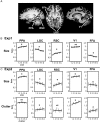Parametric Coding of the Size and Clutter of Natural Scenes in the Human Brain
- PMID: 24436318
- PMCID: PMC4459284
- DOI: 10.1093/cercor/bht418
Parametric Coding of the Size and Clutter of Natural Scenes in the Human Brain
Abstract
Estimating the size of a space and its degree of clutter are effortless and ubiquitous tasks of moving agents in a natural environment. Here, we examine how regions along the occipital-temporal lobe respond to pictures of indoor real-world scenes that parametrically vary in their physical "size" (the spatial extent of a space bounded by walls) and functional "clutter" (the organization and quantity of objects that fill up the space). Using a linear regression model on multivoxel pattern activity across regions of interest, we find evidence that both properties of size and clutter are represented in the patterns of parahippocampal cortex, while the retrosplenial cortex activity patterns are predominantly sensitive to the size of a space, rather than the degree of clutter. Parametric whole-brain analyses confirmed these results. Importantly, this size and clutter information was represented in a way that generalized across different semantic categories. These data provide support for a property-based representation of spaces, distributed across multiple scene-selective regions of the cerebral cortex.
Keywords: fMRI; multivoxel pattern analysis; scene and space perception; the parahippocampal place area; the retrosplenial cortex.
© The Author 2014. Published by Oxford University Press. All rights reserved. For Permissions, please e-mail: journals.permissions@oup.com.
Figures








References
-
- Bar M, Aminoff E. 2003. Cortical analysis of visual context. Neuron. 38:347–358. - PubMed
Publication types
MeSH terms
Grants and funding
LinkOut - more resources
Full Text Sources
Other Literature Sources

